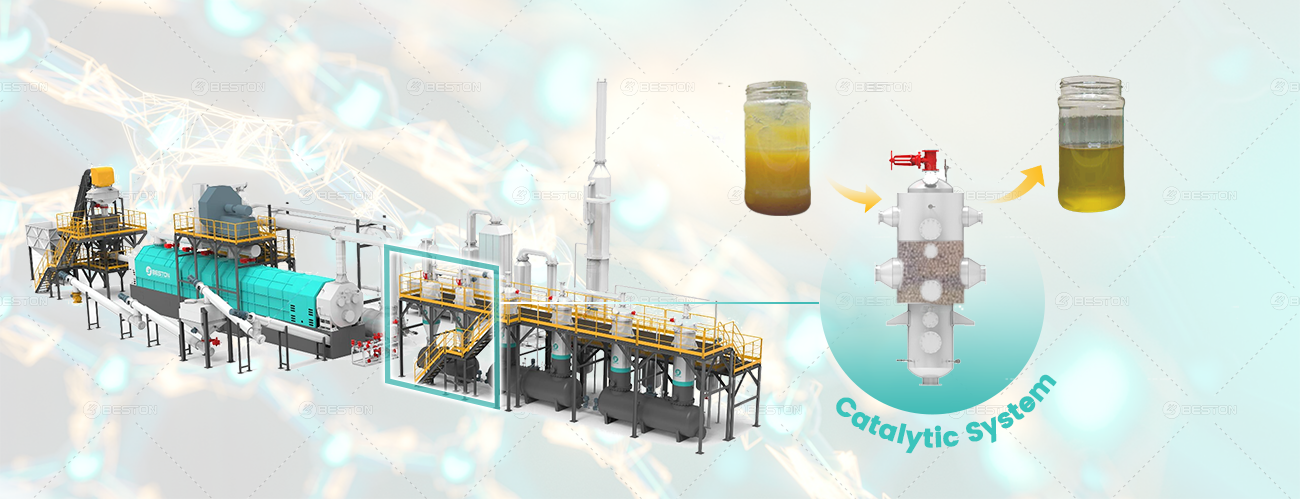Strategies to Minimize Wax Oil Formation in Plastic Pyrolysis

The efficiency of a pyrolysis plant converting waste plastic into usable fuel depends heavily on the chemical pathways taken during the cracking process. One of the most persistent challenges in plastic pyrolysis is the unintended formation of wax oil—a viscous, semi-solid byproduct with limited industrial value and poor flow characteristics. Minimizing or preventing its generation is critical for maximizing liquid oil yield and enhancing system stability.
The Chemistry Behind Wax Oil Formation
Wax oil forms predominantly when long-chain hydrocarbons produced during depolymerization do not undergo sufficient secondary cracking. This typically occurs under suboptimal thermal conditions or when residence time is too short in the high-temperature zone of the reactor. Specifically, polyethylene (PE) and polypropylene (PP)—the most common plastic waste feedstocks—tend to yield waxy compounds if the cracking temperature remains below 400°C.
In addition to temperature, the rate of feedstock heating and the absence of a suitable catalyst influence hydrocarbon chain scission. Incomplete breakdown leads to paraffinic hydrocarbons with high molecular weight, manifesting as wax oil. Once accumulated, wax oil can clog condensation lines, lower overall oil recovery efficiency, and necessitate frequent maintenance shutdowns.
Reactor Design Optimization
A critical variable in preventing wax oil lies in reactor engineering. A continuous plastic pyrolysis equipment with an elongated high-temperature reaction zone allows better control over residence time and thermal exposure. Rotary kiln reactors and fluidized bed systems outperform batch models by maintaining consistent heat profiles and enabling uniform material mixing.
The inclusion of internal mixing blades or screw augers ensures feedstock remains evenly exposed to heat, promoting complete depolymerization. Additionally, implementing a staged heating approach—wherein temperature gradually increases from preheating to cracking zone—can aid in breaking down complex plastic polymers more completely.
Catalyst Selection and Application
Catalytic pyrolysis is a proven method to reduce wax oil generation. Catalysts accelerate secondary cracking reactions and lower the activation energy required for carbon chain breakdown. Zeolite-based catalysts, particularly ZSM-5 and Y-zeolite, are widely used due to their strong acidity and shape-selectivity.
Catalysts can be introduced in-situ—mixed with feedstock—or placed in a downstream cracking chamber. The latter method allows for selective conversion of condensable wax vapor into lighter hydrocarbons before they solidify. However, the catalyst choice must align with the chemical nature of the feedstock and reactor configuration to avoid undesired side reactions.
Feedstock Preparation and Segregation
Not all plastics yield the same results. Feedstock heterogeneity increases the likelihood of wax oil formation. High-density polyethylene (HDPE), for example, has a higher wax-forming tendency compared to polystyrene (PS) or polyethylene terephthalate (PET). Therefore, segregating plastic streams and pre-processing materials—such as shredding into uniform particles—contributes to more predictable and efficient thermal degradation.
Moisture and contaminants, such as PVC or metal residues, also hinder reaction efficiency and can affect temperature distribution inside the reactor. A pre-drying and screening stage should be incorporated into the feeding system of the plastic to fuel machine to ensure consistent feed quality.
Temperature Control and Heat Transfer Efficiency
Maintaining a steady operational temperature—typically between 450°C and 500°C—is fundamental. Temperature fluctuations result in uneven cracking and can promote partial polymer breakdown. Installing multi-point thermocouple arrays and PID-controlled heating systems ensures thermal precision throughout the reaction chamber.
Furthermore, enhancing heat transfer by using heat-conductive inserts or improving insulation reduces energy loss and sharpens the temperature gradient. Faster and more uniform heating discourages the formation of intermediate wax compounds.
Post-Condensation Vapor Cracking
In some cases, wax vapor escapes the reactor but solidifies in the condensation unit. Incorporating a secondary high-temperature vapor cracker between the reactor and condenser allows for in-line treatment of these vapors. This unit can be electrically or thermally heated and may include a catalytic bed to further convert long-chain hydrocarbons into lighter fractions.
Operational Protocols and Monitoring
Preventing wax oil also involves consistent operational discipline. Operators should adhere to standardized ramp-up and cool-down procedures and avoid sudden feedstock surges that may disrupt thermal equilibrium. Data logging and real-time monitoring of key parameters—temperature, pressure, vapor flow rate—enable predictive maintenance and quick corrective actions.
